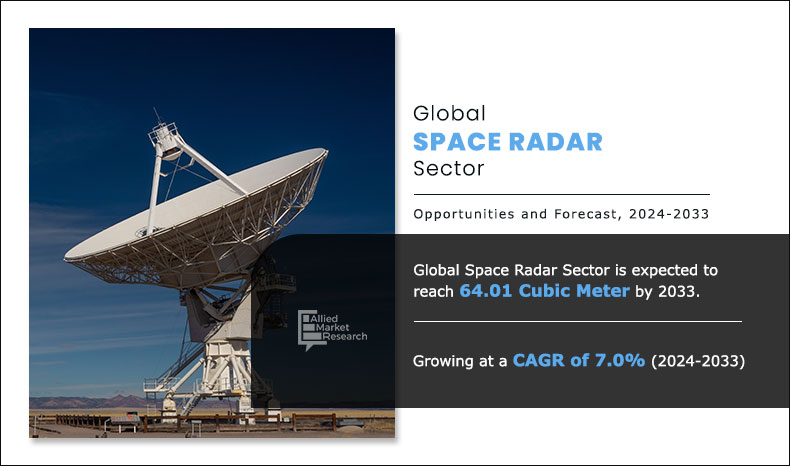Volume Insights on Space Radar Sector

Volume Insights Strategic Overview
Allied Market Research announces the release of its comprehensive analysis of global number of space radar systems. Designed to provide high-resolution imaging regardless of weather or lighting conditions, Space radar plays a crucial role in Earth observation, enabling precise assessment of land use, natural resources, and ecosystem health, particularly in regions facing challenging environmental conditions.
The report highlights the growing demand for space radar, an advanced remote sensing technology that uses radar signals to generate high-resolution images of Earth's surface, regardless of weather conditions or daylight availability. Unlike optical imaging systems, SAR can penetrate through clouds, rain, and even vegetation, making it highly reliable for continuous monitoring. It operates by emitting radio waves towards the surface and measuring the returned signals, creating detailed two- or three-dimensional images.
The steady growth in space radar is attributed to its ability to provide high-resolution imagery in all weather conditions, day, or night, making it indispensable for applications like environmental monitoring, defense, disaster management, and precision agriculture. The global volume of space radar is expected to grow from 33.47 Cubic Meter in 2023 to 64.02 Cubic Meter by 2033, registering a CAGR of 7.0% during the forecast period. Rapid expansion of space radar is supported by rise in awareness of the importance of real-time data for sustainable resource management and infrastructure planning, which drives the adoption of SAR across various industries.
Regional Space Radar Sector Volume Growth
North America dominated the space radar sector sales with 44.90% share in 2024 and a 5.6% CAGR, while Asia-Pacific, Europe, and LAMEA show strong growth at 8.2%, 9.2%, and 3.4% CAGR from 2024 to 2033, respectively, driven by regional agricultural trends and sustainability efforts.
The regional analysis highlights significant variations in adoption trends and sector sales potential across the globe. North America leads the sector volume growth, contributing over 44.90% of the total volume in 2024 and is expected to grow at a CAGR of 5.6%, driven by space radar expansion and rise in awareness of sustainable practices in countries like U.S., Canada, and Mexica. Asia-Pacific, led by the China and Japan, is projected to maintain steady growth at a 18.63% CAGR, fueled by increasing investments in space programs, advancements in remote sensing technologies, and rise in demand for SAR applications in agriculture, disaster management, and defense across like China, India, and Japan. Europe, with key players such as Germany, France, and Russia, is expected to grow at a 9.5% CAGR, supported by favorable government policies and technological advancements in space radar. Meanwhile, LAMEA offers a significant growth opportunity with a 4.6% CAGR, driven by regions like Latin America, Middle East, and Africa, where synthetic aperture radars are challenged by high development costs, complex data interpretation, and limitations in power consumption.
Space Radar Sector Volume Forecast, by Region, 2023-2033 (Cubic Meter)
Region | 2024 | 2028 | 2033 | CAGR (2024–2033) |
North America | 8.43 | 9.48 | 12.57 | 4.5% |
Europe | 4.22 | 5.21 | 7.82 | 7.1% |
Asia-Pacific | 4.39 | 5.91 | 9.26 | 8.0% |
LAMEA | 1.8 | 1.89 | 2.22 | 2.3% |
Total | 19.07 | 22.49 | 31.88 | 5.9% |
Source: AMR Analysis
Space Radar Country Sector Sales
U.S. and the China lead the space radar sector volume forecast, projected to reach 20.16 cubic meter and 9.4 cubic meter by 2033 at 4.9% and 7.2% CAGR, respectively, while India (11.3% CAGR) and Latin America (5.9% CAGR) emerge as high-growth regions driven by advancement in satellite technology, and defense application.
The report identifies China and the U.S. as the largest contributors to the space radar sector in terms of volume. The U.S., with its extensive space radar capabilities and growing emphasis on sustainable practices, continues to lead advancements in space surveillance and environmental monitoring., is projected to reach 9.89 cubic meter by 2033, achieving a CAGR of 4.67%. China, on the other hand, remains an important player in Asia-Pacific, growing at a steady 6.1% CAGR accounting for 4.67 cubic meter by 2033.
Emerging countries such as India and Latin America are expected to drive significant growth of the space radar ecosystem due to rise in investments in space technology, defense modernization, and environmental monitoring initiatives. India, benefiting from growing government investments in space exploration, advancements in satellite technology, and rise in demand for applications such as disaster management, agricultural monitoring, and defense surveillance, is expected to generate a CAGR of 10.1%, the highest among major countries. Latin America is projected to grow at a CAGR of 4.9% during the forecast period, supported by its expanding agricultural industry and favorable climate for crop cultivation.
Space Radar Sector Volume Growth, by Country, 2023-2033 (Cubic Meter)
Country | 2024 | 2028 | 2033 | CAGR (2024-2033) |
U.S. | 7.02 | 7.74 | 9.89 | 3.8% |
China | 2.75 | 3.29 | 4.67 | 6.1% |
India | 0.63 | 0.87 | 1.5 | 10.1% |
Canada | 0.77 | 1.01 | 1.5 | 7.1% |
Latin America | 0.32 | 46.5 | 58.8 | 4.9% |
Mexico | 0.53 | 0.79 | 1.18 | 9.3% |
Germany | 0.79 | 1.03 | 1.66 | 8.6% |
Source: AMR Analysis
Key Highlights by Stakeholders
Highlighting the significance of this report, Ashwani Ajwani, Vice-President of Allied Market Research, stated, “The growing demand for advanced space-based monitoring solutions has made synthetic aperture radar (SAR) an essential component of modern space exploration and Earth observation. Our latest report captures the sectors dynamics, offering actionable insights for stakeholders looking to leverage this transformative technology.”
He further added, “North America, with its advancements in space exploration and defense applications, remains the most promising region for the space radar sector. Meanwhile, innovations in Earth observation technologies in Asia-Pacific and Europe are driving steady growth in these regions. With this comprehensive analysis, we aim to empower our clients with the knowledge needed to make informed business decisions in this rapidly evolving sector.”
Space Radar Sector Volume Trends
The report also emphasizes the growing role of advanced and miniaturized space radar technologies, including synthetic aperture radar (SAR), in addressing the need for high-resolution, environmentally sustainable solutions for Earth observation and space exploration. With rise in demand for data-driven environmental monitoring and government initiatives promoting green technologies, the adoption of space radar systems is expected to rise in the coming years. This shift is encouraging manufacturers to innovate and develop SAR systems that not only deliver enhanced imaging capabilities but also minimize power consumption and operational costs.
In addition, technological advancements such as AI-driven data processing, real-time analytics, and lightweight radar components are significantly influencing the space radar sector. The integration of machine learning and automation enables faster and more accurate interpretation of radar data, optimizing applications like disaster management, resource mapping, and climate monitoring. These innovations are expected to boost the demand for high-performance, versatile SAR systems tailored to diverse applications across defense, commercial, and environmental sectors.
Furthermore, the study explores the impact of climate change on global monitoring needs. With extreme weather events and environmental degradation becoming more frequent, space radar is increasingly recognized as a vital tool for tracking deforestation, melting glaciers, and rising sea levels. Its ability to operate under all weather conditions and provide consistent, high-resolution imaging makes SAR indispensable in addressing these challenges.
Key trends in the space radar sector include the deployment of low-cost small satellites equipped with SAR capabilities, rise of commercial SAR data services, and advancements in interferometric SAR (InSAR) for detailed terrain analysis. Rise in adoption of SAR in urban planning, maritime surveillance, and infrastructure monitoring further underscores its transformative potential across various industries.
Space radar stakeholders should use the report’s insights to grab new opportunities and plan ahead.
About Allied Market Research
Allied Market Research is a full-service market research and business consulting firm, which provides actionable insights and strategic recommendations to help clients make informed decisions and achieve sustainable growth. For more inquiries, please visit alliedmarketresearch.com


